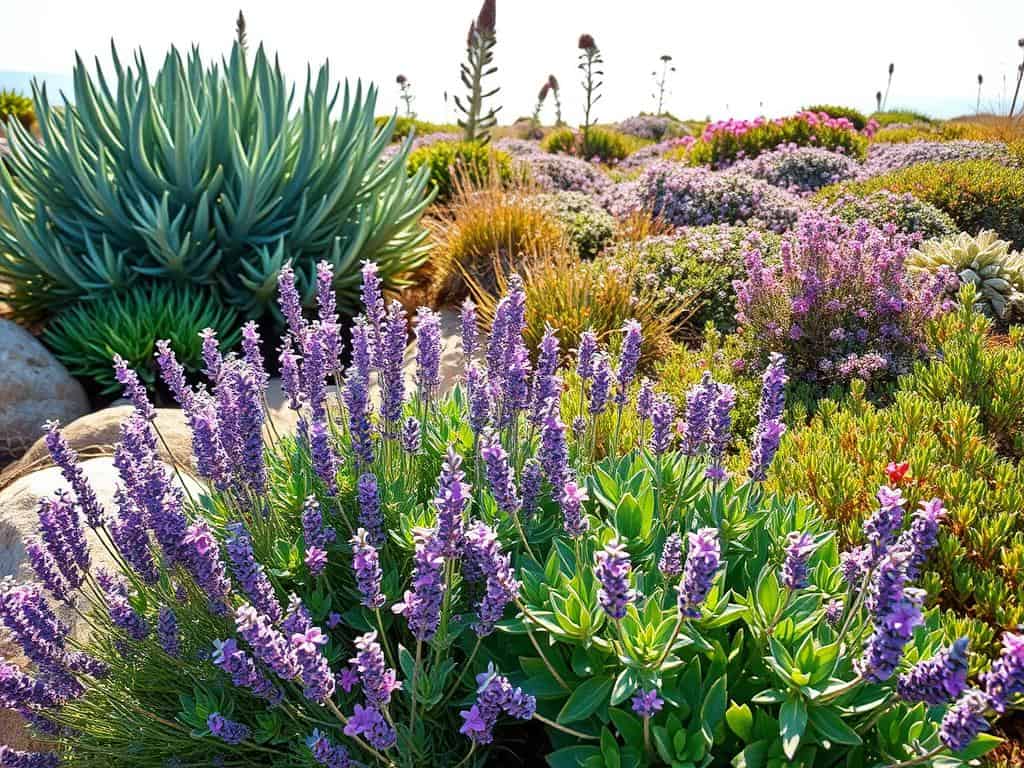Standing on the sun-drenched sands, I was amazed by nature’s strength. I remembered planting my first *beachside horticulture* project—a colorful array of seaside flowers. They danced in the salt-laden wind, but coastal gardening was tough. The winds were fierce, the soil was sandy and poor, and the salty air was hard to handle.
My experience taught me a lot about *seaside landscaping*. Each plant I chose showed my determination and love for gardening by the sea. In this article, I’ll explore coastal gardening’s challenges, the right plants, and tips for a thriving seaside garden.
Key Takeaways
- Coastal gardening requires understanding the unique environment of seaside regions.
- Salt exposure and sandy soil are major challenges that need addressing.
- Choosing salt-tolerant plants is key for thriving coastal gardens.
- Perennials and annuals can make your seaside landscape beautiful.
- Soil preparation strategies help create a nurturing ground for plants.
- Designing for wind resistance can protect vulnerable plants.
Understanding the Challenges of Coastal Gardening
Coastal gardening comes with its own set of challenges. Wind and salt exposure are the main hurdles. These elements can harm plant health and growth. So, I must choose my plants wisely.
Each challenge needs a specific solution for a successful coastal garden.
Wind and Salt Exposure
Wind in coastal areas can be very strong. It can damage plants, from broken stems to uprooted ones. I need to pick plants that can handle this.
Salt from ocean spray also poses a problem. It can burn leaves and stop plants from growing. Knowing how to deal with salt is key to a healthy garden.
Sandy and Nutrient-Lean Soil
Sandy soil is another big challenge. It drains fast, leaving plants thirsty and without enough nutrients. Sandy soil is airy, but it needs extra care.
I have to water carefully and add organic materials to improve the soil. This helps my coastal garden thrive.
Choosing Plants for Coastal Environments
Creating a coastal garden means picking the right plants for the salty air and soil. I focus on salt-tolerant flora to make a strong landscape. These plants handle the salty air and soil well, making them great for the coast.
Salt-Tolerant Flora
Lavender, yarrow, and portulaca are top picks for coastal gardens. They show my dedication to growing plants that do well in tough coastal conditions. Their ability to adapt adds beauty and harmony to the garden, even with sandy soil and strong winds.
Perennials and Annuals Ideal for the Coast
Using a mix of coastal plants like perennials and annuals makes the garden look better. Daylilies, red-hot pokers, and sea oats are great examples. I choose these for their colors, textures, and ability to handle coastal challenges. With the right planning, my garden becomes more diverse and needs less care over time.

Coastal Gardening: Tips for Successful Planting
Creating a coastal garden is all about understanding the unique challenges of the area. I focus on two key areas: preparing the soil and designing plants to resist wind. These steps help my plants thrive in the coastal environment.
Soil Preparation Strategies
Improving soil health is my first step. Sandy coastal soils often lack nutrients, which slows plant growth. To fix this, I add compost and well-rotted manure to the soil. This boosts nutrient levels and supports strong roots.
With good soil preparation, my coastal plants have the best chance to grow well.
Designing for Wind Resistance
Wind resistance is vital for coastal plants. I group plants together to protect them from strong winds. This method helps each plant grow stronger.
I also place plants to create a beautiful, natural look. This design not only withstands wind but also looks great.
Conclusion
Successful coastal gardening mixes smart planning with knowing the coastal challenges. Choosing salt-tolerant plants is key to their survival and growth. Soil preparation is also vital, as it boosts nutrient levels for a healthy garden.
Designing my garden to withstand wind helps my plants thrive. Regular care, like watering and using organic fertilizers, keeps my garden healthy. This care is essential for a long-lasting and vibrant garden.
My hard work will create a lively, beautiful space that matches the ocean’s calm. These practices make coastal gardening rewarding. They also let me enjoy a garden that truly captures the spirit of seaside living.



